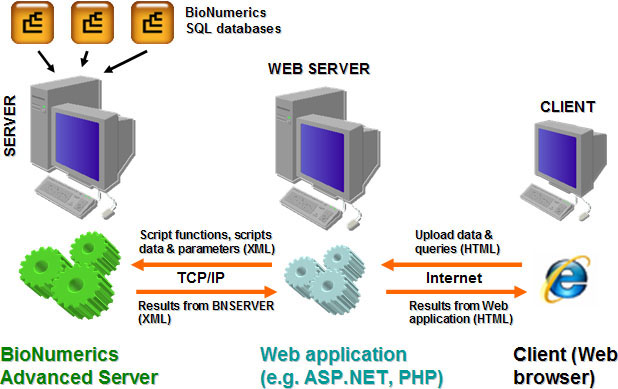BioNumerics Server is a Powerful Client-Server solution for secure exchange and analysis of biological data. It provides the platform to build Web-servers enabling querying, upload, download and numerous advanced BIONUMERICS tools for browser-based clustering and identification.
BioNumerics Server has built and proven its reputation as the rock-solid and invaluable core of numerous public and private exchange, typing, and surveillance networks worldwide, of which the PulseNet initiative is undoubtedly the most prestigious example.
With BioNumerics Server, we combined all the existing client-server based connectivity and functionality with a platform to build interactive, web browser-based services. Clients can connect to a BioNumerics Server from all over the world using their web browser and run queries, perform identifications, generate clusterings, or display phylogenetic trees within a web environment.
Contact us for a personalized price offer!
BioNumerics Server features
BioNumerics Server provides two solutions for sharing its databases and offering its services: a direct TCP/IP socket-based connection and a web-based communication. The socket-based connection is particularly designed for client-server platforms that include upload and download actions, whereas the web-based solution is suitable to provide services such as identifying unknown samples, placing an unknown sample in a dendrogram of database matches, assigning allelic and VNTR types, etc. Using the web-based functionality, the client does not need BioNumerics.
General BioNumerics Server features
- Fully automatic Windows NT service which runs in the background and which is multi-threaded (multiple clients are processed simultaneously);
- Serving many databases at the same time; limited only by computer capacity;
- Full control over accessibility of every individual database component per Client;
- Login and password protection of databases;
- Automatic transfer of queries from the server database as requested by a client;
- Automatic identification of batches of entries sent by a client, and subsequent storage and return of detailed identification reports;
- Recording of detailed history files of all events with indication of login time and client’s account;
Features of socket-based connection:
- Optional 256-bit encryption for transfer of sensitive data;
- Automatic upload of data sent by a client (“Incoming” directory). In case of fingerprint patterns, optional upload of full database info including image file, to allow re-editing at the Server site.
- Download of any selection of entries from the database and containing any selection of experiments and information fields;
- Import of foreign Server database selections in own database with possibility to compatibilize common data components;
- Easy connect to Server and upload of data or complete experiment data files;
- Real-time identification and receipt of detailed identification report;
- Extensive functions for interactive Server querying;
- Download of queries from Server database and optional saving in local database.
Features of web-based connection:

For maximal flexibility, the Server application (BioNumerics Server) and Web application are separated applications and can even be installed on different computers. The communication between BioNumerics Server and the Web application happens through XML over TCP/IP (see scheme). The Web application is platform independent (e.g. ASP.NET on Windows, PHP on Linux).
Numerous advanced BIONUMERICS analysis tools available for browser-based database querying and comparison:
- Similarity-based dendrograms such as UPGMA, SL, CL, Ward, and Neighbor Joining;
- Phylogenetic trees such as Parsimony;
- Minimum Spanning Trees;
- Principal Components Analysis and Discriminant Analysis;
- Pairwise and Multiple Alignment;
- All available similarity coefficients and identification methods.
